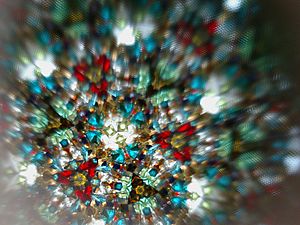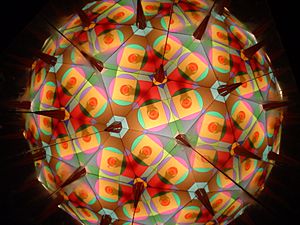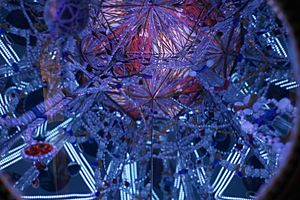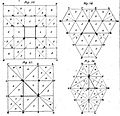Kaleidoscope facts for kids
A kaleidoscope is an optical instrument with two or more reflecting surfaces tilted to each other in an angle, so that one or more (parts of) objects on one end of the mirrors are seen as a regular symmetrical pattern when viewed from the other end, due to repeated reflection. The reflectors (or mirrors) are usually enclosed in a tube, often containing on one end a cell with loose, colored pieces of glass or other transparent (and/or opaque) materials to be reflected into the viewed pattern. Rotation of the cell causes motion of the materials, resulting in an ever-changing view being presented.
History
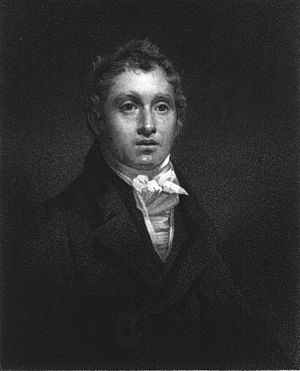
In 1815, Sir David Brewster began work that led to the invention of the kaleidoscope. At that time, he was doing experiments on light polarization. The kaleidoscope was not patented until two years later. His first design was a tube with pairs of mirrors at one end, pairs of translucent disks at the other, and beads between the two.
In 1817, Brewster chose the well-known lens developer Philip Carpenter to be the only manufacturer of the kaleidoscope. It was a big success. Two hundred thousand kaleidoscopes were sold in London and Paris in just three months. Brewster knew that the company could not make as many kaleidoscopes as people wanted. On 17 May 1818, he asked Carpenter to allow them to be made by other manufacturers. Carpenter agreed.
At first, the kaleidoscope was meant to be a scientific tool. Later it was used as a toy. Brewster believed he would make money from the kaleidoscope. However, a fault in his patent application allowed others to copy it.
In 1987, kaleidoscope artist Thea Marshall, working with the Willamette Science and Technology Center, a science museum located in the Eugene, Oregon, designed and constructed a 1,000 square foot traveling mathematics and science exhibition, "Kaleidoscopes: Reflections of Science and Art." The exhibition appeared in 15 science museums over a three year period, reaching more than one million visitors in the United States and Canada. Interactive exhibit modules enabled visitors to better understand and appreciate how kaleidoscopes function.
Later variations
Manufacturers and artists have created kaleidoscopes with a wide variety of materials and in many shapes. A few of these added elements that were not previously described by inventor David Brewster:
- object cells have been filled with a viscous liquid so the items float and move gracefully through the object cell in response to slight movements from the viewer
- wand kaleidoscopes, with a movable transparent sealed tube containing liquid showing sinking and/or floating objects (usually including glitter) past the end of the reflectors, were introduced in 1990
- object wheels or carousels rotating on an axis attached to the center of kaleidoscope can introduce shapes and colors into the kaleidoscope image
- exteriors of kaleidoscopes have been crafted into sculptural artworks
- large kaleidoscopes have been integrated in the architecture of some buildings
- software and digital cameras have been used in high tech kaleidoscopes
Applications
Most kaleidoscopes are mass-produced from inexpensive materials, and intended as children's toys. At the other extreme are handmade pieces that display fine craftsmanship. Craft galleries often carry a few kaleidoscopes, while other enterprises specialize in them, carrying dozens of different types from different artists and craftspeople. Most handmade kaleidoscopes are now made in Japan, the USA, Russia and Italy, following a long tradition of glass craftsmanship in those countries.
Images for kids
See also
 In Spanish: Caleidoscopio para niños
In Spanish: Caleidoscopio para niños


